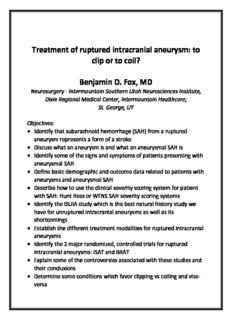
Treatment of ruptured intracranial aneurysm: to clip or to coil? PDF
Preview Treatment of ruptured intracranial aneurysm: to clip or to coil?
Treatment of ruptured intracranial aneurysm: to clip or to coil? Benjamin D. Fox, MD Neurosurgery - Intermountain Southern Utah Neurosciences Institute, Dixie Regional Medical Center, Intermountain Healthcare; St. George, UT Objectives: • Identify that subarachnoid hemorrhage (SAH) from a ruptured aneurysm represents a form of a stroke • Discuss what an aneurysm is and what an aneurysmal SAH is • Identify some of the signs and symptoms of patients presenting with aneurysmal SAH • Define basic demographic and outcome data related to patients with aneurysms and aneurysmal SAH • Describe how to use the clinical severity scoring system for patient with SAH: Hunt Hess or WFNS SAH severity scoring systems • Identify the ISUIA study which is the best natural history study we have for unruptured intracranial aneurysms as well as its shortcomings • Establish the different treatment modalities for ruptured intracranial aneurysms • Identify the 2 major randomized, controlled trials for ruptured intracranial aneurysms: ISAT and BRAT • Explain some of the controversies associated with these studies and their conclusions • Determine some conditions which favor clipping vs coiling and vise- versa • Describe some of the controversies associated with treatment of ruptured intracranial aneurysms Treatment of Ruptured Intracranial Aneurysms: To Clip or Coil? Benjamin Fox, M.D. Medical Director‐ Neurosurgery Intermountain Healthcare Neuro‐interventional Medical Director Dixie Regional Medical Center Disclosures • Employee of Intermountain Healthcare / Intermountain Medical Group • No financial relationships with any other medical/surgical/endovascular companies • I am a neurosurgeon & • I am a neurointerventionalist • American Stroke Association • Stroke Classifications • Ischemic Stroke • Hemorrhagic Stroke • Subarachnoid Hemorrhage (5% of all Strokes) • Intraparenchymal Hemorrhage (IPH) • Intracerebral hemorrhage (ICH) Types of Strokes 58 yo female with worst headache of her life Subarachnoid Hemorrhage (SAH) • Trauma • most common cause of SAH • Spontaneous SAH (5% of strokes) • Ruptured intracranial aneurysms (~75%) • No cause determined (15%) • perimesencephalic hemorrhages • AVMs (4%) • more commonly ICH/IVH • Rare Causes • Coagulation disorders • Vasculitides • Dissection • Dural venous sinus thrombosis Greenberg
Description: